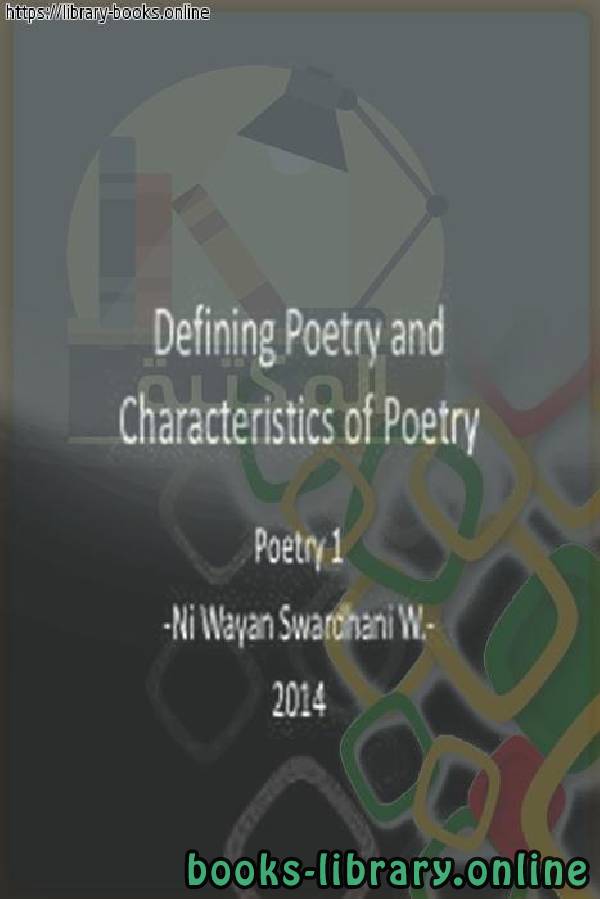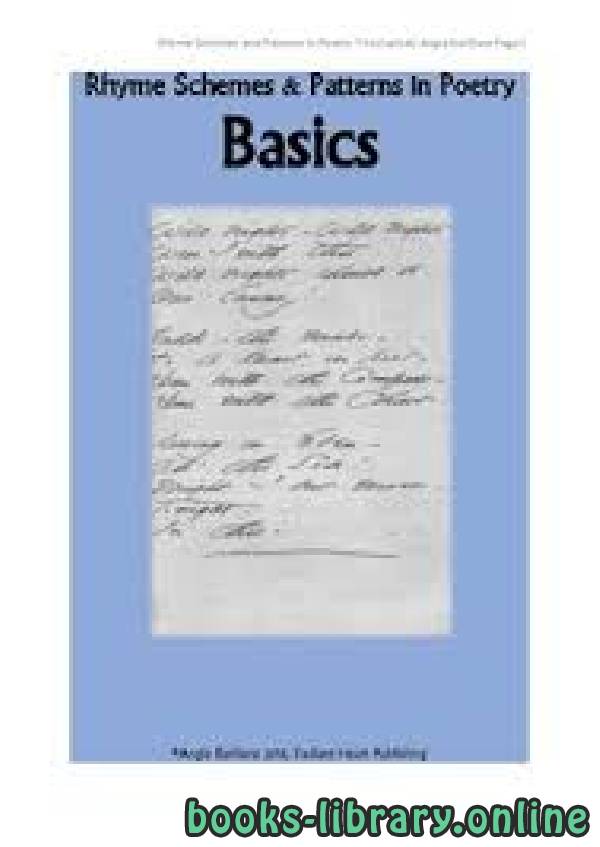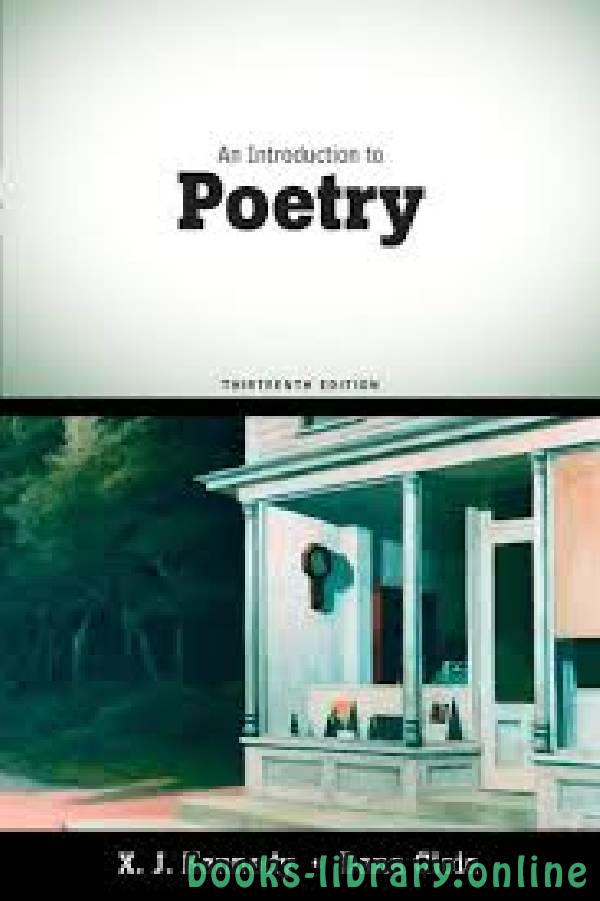كتاب Defining Poetry and Characteristics of Poetry
Defining Poetry and Characteristics of Poetry a universal phenomenon --- exists along human’s civilization • from primitive to developed nation • from spell to drive away evil soul to conventional one (from oral to written) • enjoyed by everyone entertainment and understanding • never dies “To fully understand Poetry, we first must be fluent with its meter, rhyme, and figures of speech. Then ask two questions; one, how are fully the objective of the poem have been rendered, and two, how important is the objective. Question one rates the poem’s perfection, question two rates its importance. And once these questions have been answered, turning the poem’s greatness into relatively simple matter.Wayan Swardhani - ❰ له مجموعة من الإنجازات والمؤلفات أبرزها ❞ Defining Poetry and Characteristics of Poetry ❝ ❱
من الشعر Poetry كتب تعلم اللغة الإنجليزية - مكتبة كتب تعلم اللغات.

قراءة كتاب Defining Poetry and Characteristics of Poetry أونلاين
معلومات عن كتاب Defining Poetry and Characteristics of Poetry:
Characteristics of Poetry
a universal phenomenon --- exists along
human’s civilization
• from primitive to developed nation
• from spell to drive away evil soul to
conventional one (from oral to written)
• enjoyed by everyone entertainment and
understanding
• never dies
“To fully understand Poetry, we first must be
fluent with its meter, rhyme, and figures of
speech. Then ask two questions; one, how are
fully the objective of the poem have been
rendered, and two, how important is the
objective. Question one rates the poem’s
perfection, question two rates its importance.
And once these questions have been
answered, turning the poem’s greatness into
relatively simple matter.
سنة النشر : 2014م / 1435هـ .
عدد مرات التحميل : 5490 مرّة / مرات.
تم اضافته في : الإثنين , 30 ديسمبر 2019م.
حجم الكتاب عند التحميل : 1.0MB .
تعليقات ومناقشات حول الكتاب:
هذا القسم يحتوي علي العديدمن المصادر التي تختص بالشعر وعلومه.
يصعب تعريف الشعر بطريقة تشمل أنواعه في مختلف اللغات، لكن هناك عدد من التعريفات التي قد تعطي معنى متكاملاً عن ماهية الشعر. عُرّف الشعر بأنه كلام موزون مقفىّ (للشعر العربي)، دالٌ على معنى، ويكون أكثر من بيت، ويشمل هذا التعريف النظم. وقال بعضهم: هو الكلام الذي قصد إلى وزنه وتقفيته قصداً أولياً، فأما ما جاء عفو الخاطر من كلام لم يقصد به الشعر فلا يقال له شعر، وإن كان موزونا. وقد عرفه ابن خلدون بأنه: «هو الكلام البليغ المبني على الاستعارة والأوصاف، المفصل بأجزاء متفقة في الوزن والروي، مستقل كل جزء منها في غرضه ومقصده عما قبله وبعده، الجاري على أساليب العرب المخصوصة به». الشعر: هو شكل من أشكال الفن الأدبي في اللغة التي تستخدم الجمالية والصفات بالإضافة إلى أو بدلاً من معنى الموضوع الواضح. قد تكون كتابة الشعر بشكل مستقل، وقصائد متميزة، أو قد تحدث جنبا إلى جنب مع الفنون الأخرى، كما في الدراما الشعرية، التراتيل، النصوص الشعرية، أو شعر النثر. أما من الناحية المعنوية فإن الشعر هو العِلم.
Poetry (derived from the Greek poiesis, "making") is a form of literature that uses aesthetic and rhythmic qualities of language—such as phonaesthetics, sound symbolism, and metre—to evoke meanings in addition to, or in place of, the prosaic ostensible meaning.
Poetry has a long history dating back to prehistoric times with hunting poetry in Africa, and to panegyric and elegiac court poetry of the empires of the Nile, Niger, and Volta River valleys.[4] Some of the earliest written poetry in Africa is found among the Pyramid Texts written during the 25th century BCE. The earliest Western Asian epic poetry, the Epic of Gilgamesh, was written in Sumerian.
Early poems in the Eurasian continent evolved from folk songs such as the Chinese Shijing; or from a need to retell oral epics, as with the Sanskrit Vedas, the Zoroastrian Gathas, and the Homeric epics, the Iliad and the Odyssey. Ancient Greek attempts to define poetry, such as Aristotle's Poetics, focused on the uses of speech in rhetoric, drama, song, and comedy. Later attempts concentrated on features such as repetition, verse form, and rhyme, and emphasized the aesthetics which distinguish poetry from more objectively-informative prosaic writing.
Poetry uses forms and conventions to suggest differential interpretation to words, or to evoke emotive responses. Devices such as assonance, alliteration, onomatopoeia, and rhythm are sometimes used to achieve musical or incantatory effects. The use of ambiguity, symbolism, irony, and other stylistic elements of poetic diction often leaves a poem open to multiple interpretations. Similarly, figures of speech such as metaphor, simile, and metonymy[5] create a resonance between otherwise disparate images—a layering of meanings, forming connections previously not perceived. Kindred forms of resonance may exist, between individual verses, in their patterns of rhyme or rhythm.
Some poetry types are specific to particular cultures and genres and respond to characteristics of the language in which the poet writes. Readers accustomed to identifying poetry with Dante, Goethe, Mickiewicz, or Rumi may think of it as written in lines based on rhyme and regular meter. There are, however, traditions, such as Biblical poetry, that use other means to create rhythm and euphony. Much modern poetry reflects a critique of poetic tradition,[6] testing the principle of euphony itself or altogether forgoing rhyme or set rhythm.[7][8] In today's increasingly globalized world, poets often adapt forms, styles, and techniques from diverse cultures and languages.
Contents
1 History
1.1 Western traditions
1.2 20th-century and 21st-century disputes
2 Elements
2.1 Prosody
2.1.1 Rhythm
2.1.2 Meter
2.1.3 Metrical patterns
2.2 Rhyme, alliteration, assonance
2.2.1 Rhyming schemes
2.3 Form in poetry
2.3.1 Lines and stanzas
2.3.2 Visual presentation
2.4 Diction
3 Forms
3.1 Sonnet
3.2 Shi
3.3 Villanelle
3.4 Limerick
3.5 Tanka
3.6 Haiku
3.7 Khlong
3.7.1 Khlong si suphap
3.8 Ode
3.9 Ghazal
4 Genres
4.1 Narrative poetry
4.2 Lyric poetry
4.3 Epic poetry
4.4 Satirical poetry
4.5 Elegy
4.6 Verse fable
4.7 Dramatic poetry
4.8 Speculative poetry
4.9 Prose poetry
4.10 Light poetry
4.11 Slam poetry
Defining Poetry and
Characteristics of Poetry
a universal phenomenon --- exists along
human’s civilization
• from primitive to developed nation
• from spell to drive away evil soul to
conventional one (from oral to written)
• enjoyed by everyone entertainment and
understanding
• never dies
“To fully understand Poetry, we first must be
fluent with its meter, rhyme, and figures of
speech. Then ask two questions; one, how are
fully the objective of the poem have been
rendered, and two, how important is the
objective. Question one rates the poem’s
perfection, question two rates its importance.
And once these questions have been
answered, turning the poem’s greatness into
relatively simple matter.
english poetry pdf
poetry books pdf
types of poetry
definitions of poetry
types of poetry
poetry english
short poetry
poetry about life
poetry elements
poetry wikipedia
poetry معنى
 مهلاً !
مهلاً !قبل تحميل الكتاب .. يجب ان يتوفر لديكم برنامج تشغيل وقراءة ملفات pdf
يمكن تحميلة من هنا 'تحميل البرنامج'

نوع الكتاب : pdf.
اذا اعجبك الكتاب فضلاً اضغط على أعجبني و يمكنك تحميله من هنا:


كتب اخرى في الشعر Poetry

الصورة الشعرية في الخطاب البلاغي والنقدى PDF
قراءة و تحميل كتاب الصورة الشعرية في الخطاب البلاغي والنقدى PDF مجانا
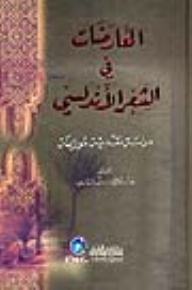
المعارضات فى الشعر الأندلسى - دراسة نقدية موازنة PDF
قراءة و تحميل كتاب المعارضات فى الشعر الأندلسى - دراسة نقدية موازنة PDF مجانا

A BOOK OF Poems: Expressions from our Youth PDF
قراءة و تحميل كتاب A BOOK OF Poems: Expressions from our Youth PDF مجانا
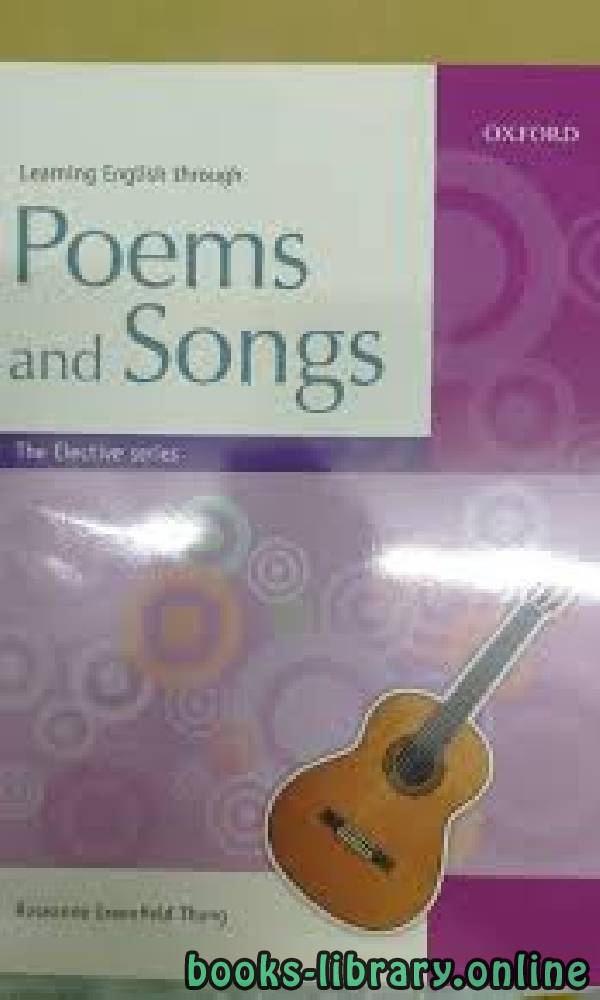
Learning English through Poems and Songs PDF
قراءة و تحميل كتاب Learning English through Poems and Songs PDF مجانا
